
 |
Eager Space | Videos by Alpha | Videos by Date | All Video Text | Support | Community | About |
|---|

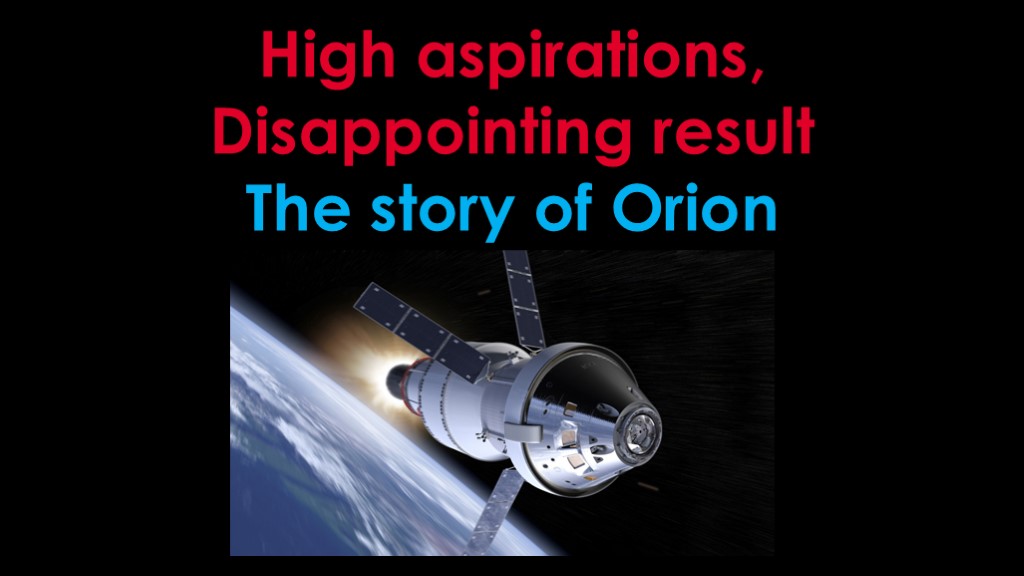
Orion is a critical component of NASA's upcoming Artemis missions to the moon, but it's not discussed very much.
It turns out there is a very interesting story
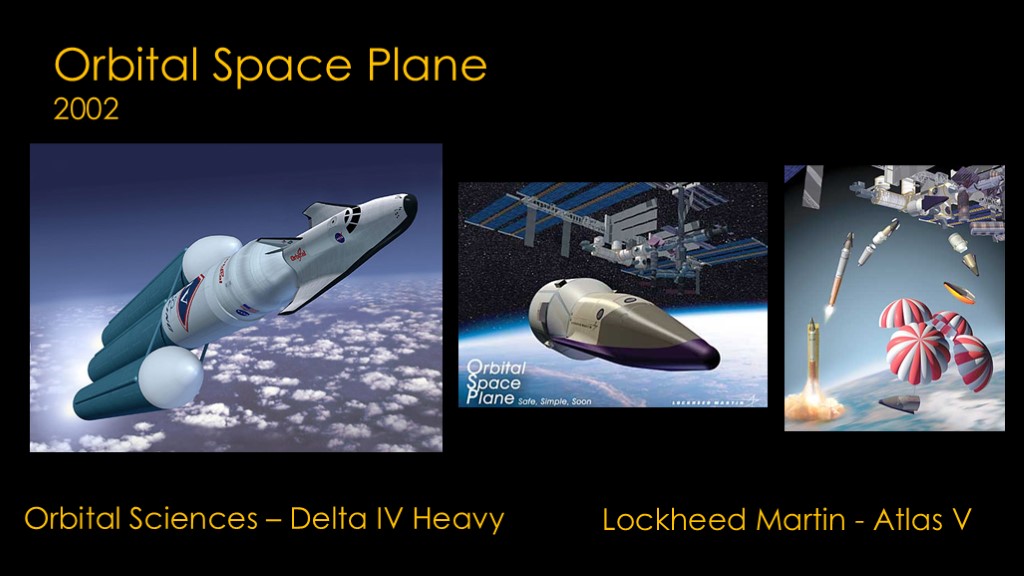
Our story starts in 2002, on a NASA project known as Orbital Space Plane. The plan was to build a small spaceplane - or even a capsule - and use it to launch astronauts or cargo to the international space station on top of commercial rockets. Here we see an orbital sciences design that would launch on the Delta IV Heavy, and a Lockheed Martin design that would launch on the Atlas V.
The intention was for this to supplement the shuttle fleet and provide complementary capabilities.
But then this happened:

After the Columbia accident, there was agreement in Congress that the shuttle should fly until the international space station was completed and then be retired.

One of the unfortunate byproducts of NASA being a government agency is that changes in administration and/or NASA administrators can change the path of the agency. This is one of those cases.

The idea of a new vision sounded to NASA like a great chance to belly up to the all-you-can eat buffet of federal money, so they dug out a bunch of proposals they had lying around, massaged them into a plan, and published it.
They called it "the vision for space exploration"

There were four high-level goals (read).
I'd like to highlight two important phrases:
The first is "sustained and affordable". The point being that this is not a program like Apollo, to visit a few times and go away.
The second is "commercial".
Both of these will come up later.
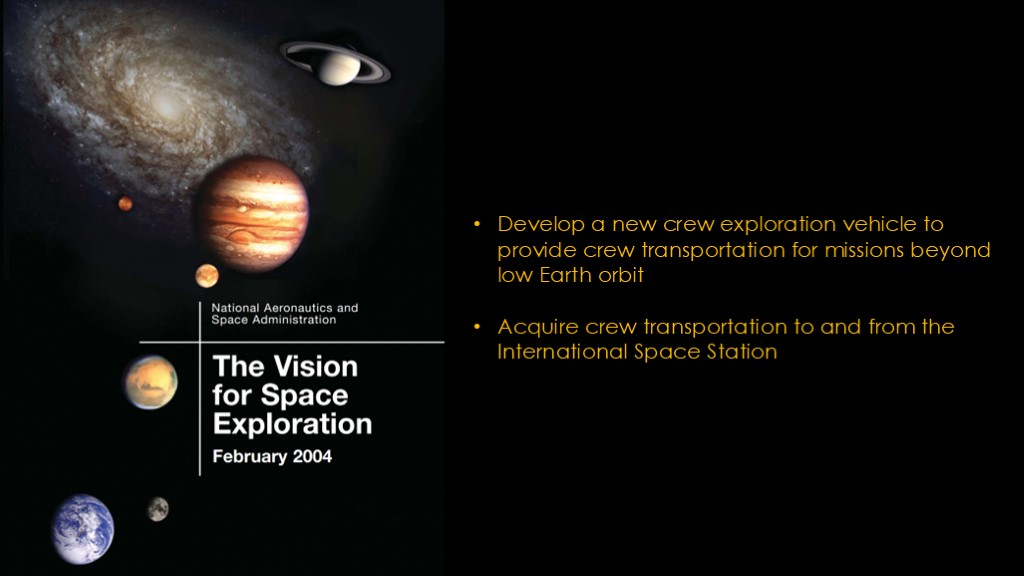
There are two sub goals that are relevant to our topic:
Develop a new crew exploration vehicle to provide crew transportations for missions beyond low earth orbit.
Acquire crew transportation to and from the international space station.
Note that these are separate goals, and note the use of the word "acquire" rather than "develop" for crew transportation.

There's a popular belief that the president is in charge of the government, and therefore in charge of NASA.
This is not true; it is congress that decides what NASA works on and how much money they can spend.
For more information on this, see my video "budgets at NASA - I'm so confused..."
We therefore need to see how Congress responded to the plan.
https://www.govinfo.gov/content/pkg/PLAW-109publ155/pdf/PLAW-109publ155.pdf

The exploration goals showed up in the NASA authorization act of 2004 and roughly aligned with the vision. It specifically instructed NASA to:
(read)
These are both about going beyond earth orbit.
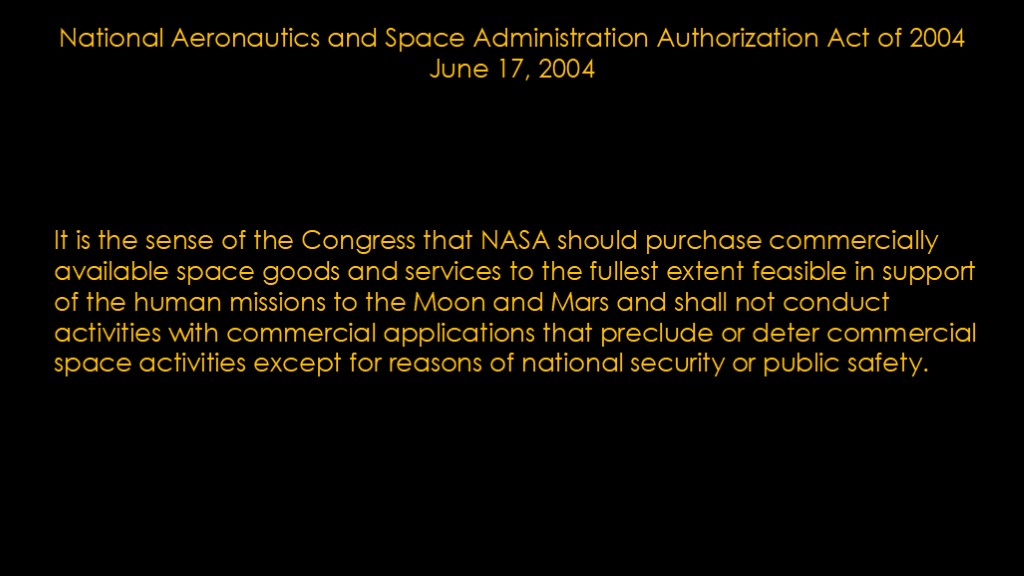
There's also an interesting requirement around commercialization
Read
This is clear direction for NASA to use commercial solutions unless there is a really good reason to do it themselves.
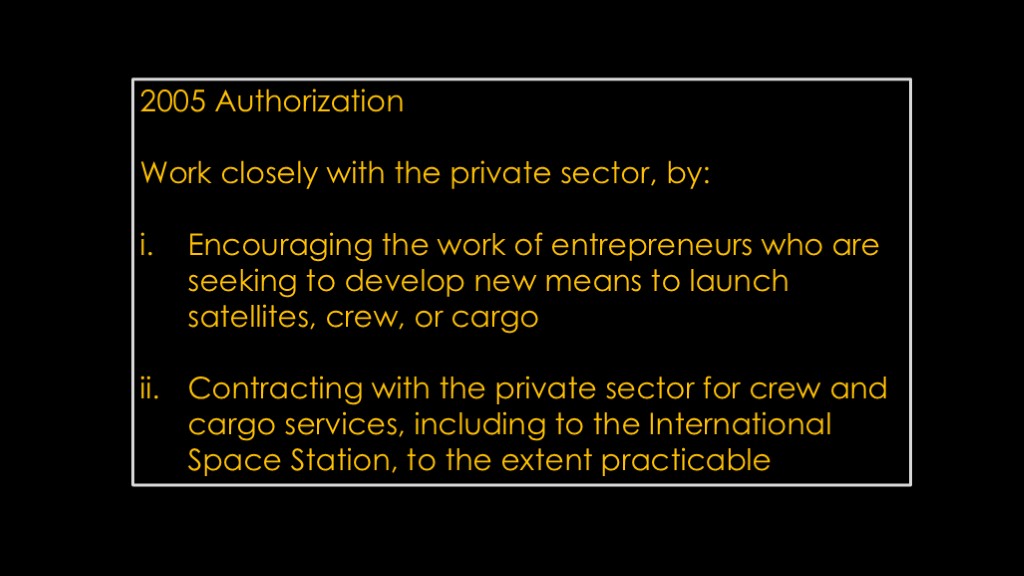
This was amplified in the 2005 authorization.
(read)
Work with new space companies to encourage them, and specifically contract with the private sector for crew and cargo services to the international space station.
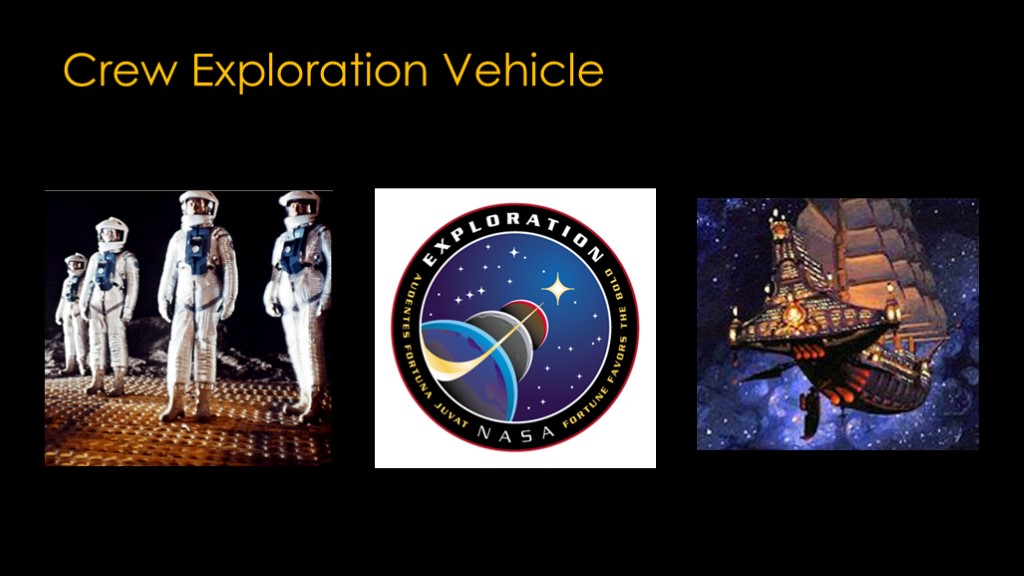
I couldn't find a official logo for the crew exploration vehicle, so this was the best I could do...
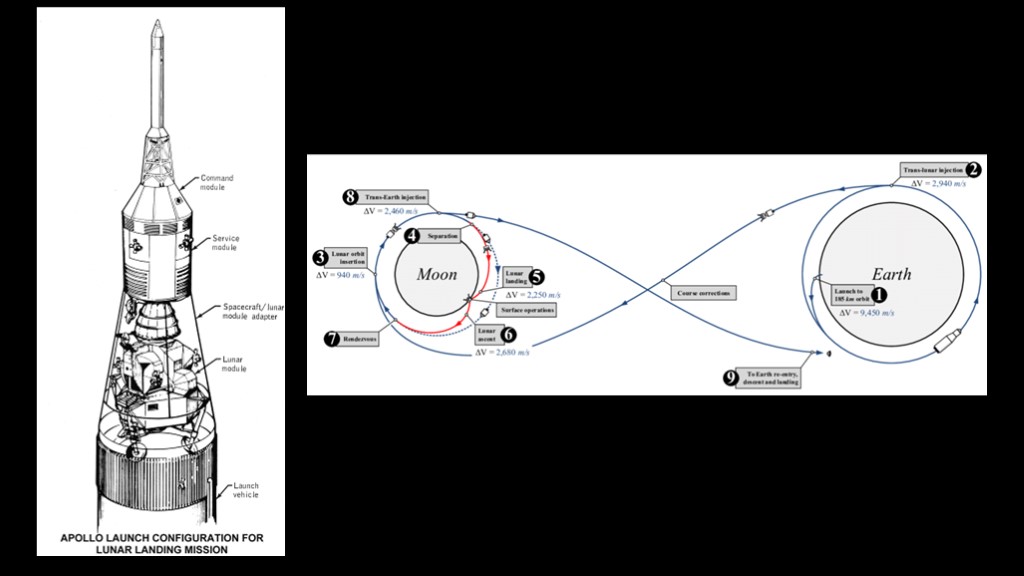
To understand the crew exploration vehicle it's important to understand the overall mission architecture, and to do that I'll need to rewind 50 years...
Apollo used an "all at once" architecture; the Saturn V launched a single stack that included the command module, the service module, and the lunar module all at once. This was a great way to get there fast, but it had some limitations...
The first is that the service module needs to have enough oomph - what we call delta v - to be able to brake the command module and the lunar module into lunar orbit *and* then have enough delta v remaining to get back out of lunar orbit and back to earth. That puts a big constraint on the mass of all three of those components; you can't, for example, increase the lunar module mass by 50% as the service module simply can't put that much mass into lunar orbit. You could make a bigger service module, but it might be too big for the Saturn V to lift. Apollo just *barely* worked, and the engineers were sweating grams of mass by the end to make it work.
Actually, this was the 60's, so they were sweating 1/28th of an ounce, but you get my point.

The architecture for this new vision - known as Constellation - is a more flexible architecture that relies on multiple launches.
There are different versions; in this version there are 4 individual launches. One for the crew vehicle, one for the lander, and two earth departure stages.
Dock the earth departure stages with the lander and crew exploration vehicle, and they take the vehicles from earth orbit all the way into lunar orbit, where they dock.
The big advantage here is that this makes it much easier to design the crew vehicle, since all it has to do is get itself back from the moon, and that's a small amount of delta V.
Essentially what it's doing is adding two more stages to the architecture, and more stages makes things easier, at least from a delta v perspective.
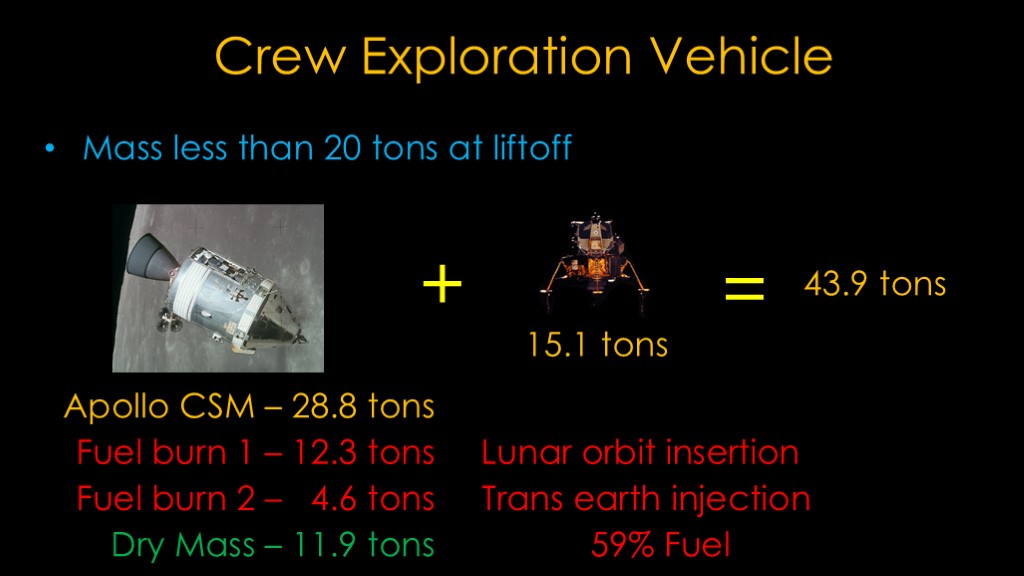
Now we can look at the requirements that NASA had for the crew exploration vehicle.
First, it needed to mass less than 20 tons at liftoff. For reference, the Apollo 11 command and service module massed about 29 tons, so how are they going to make this version so much smaller and lighter?
The Apollo CSM had a much harder job to do.
Coming from earth, it had to slow down its own mass and the mass of the lunar module, for a total mass of 43.9 tons. Getting into lunar orbit takes about 1000 meters per second of delta v.
I'll skip the detailed delta-v calculations this time, but they show that the first fuel burn required 12.3 tons of fuel.
Then after the mission, we need to get back to earth. That takes the same 1000 meters per second of delta v, but we don't have the mass of the lunar module and we don't have the mass of the fuel we burned getting into orbit, so it only requires 4.6 tons of fuel to get out of lunar orbit and back to the earth.
Subtract the fuel burn, and that tells us that the dry mass of the Apollo command and service module will be about 11.9 tons. That's all the structure, fuel tanks, engines, electronics in the service module, plus the entire command module. That whole package is about 59% fuel.
That was very hard to build, especially with the technology in the mid 1960s.
https://web.archive.org/web/20090117083711/http://prod.nais.nasa.gov/cgi-bin/eps/sol.cgi?acqid=113638
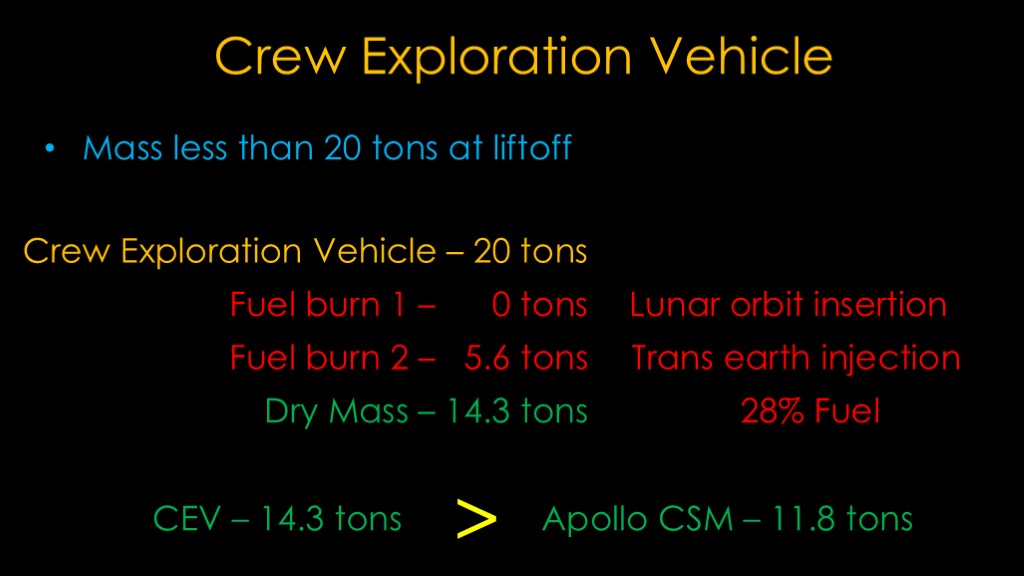
Let's do the same set of calculations for the crew exploration vehicle. It starts at 20 tons.
The lunar orbit insertion is done by the earth departure stage, so the first fuel burn is 0 tons.
Getting back to earth only takes 5.6 tons of fuel, leaving a dry mass of 14.3 tons. This means only 28% of the mass is fuel.
The dry mass of the crew exploration vehicle is considerably more than the apollo command and service module, and remember that it only needs to carry 5.6 tons of fuel instead of the 16.9 tons the apollo CSM carried, so it has smaller tanks.
And there are many more lightweight materials now.
All of that means the crew exploration vehicle will be much easier to build.
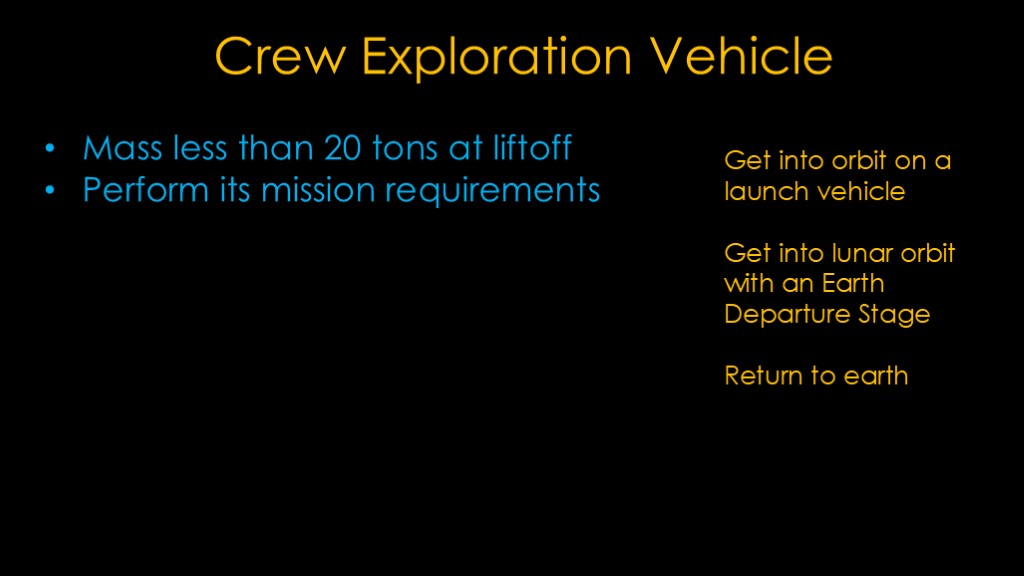
The second requirement is that the crew exploration vehicle perform it's mission requirements. It needs to hitch a ride to orbit, hitch a ride to lunar orbit, and then perform the "get home from the moon maneuver" and reenter into the earth's atmosphere and land.

Keep the astronauts alive for 16 day missions. That seems like a good thing to do.
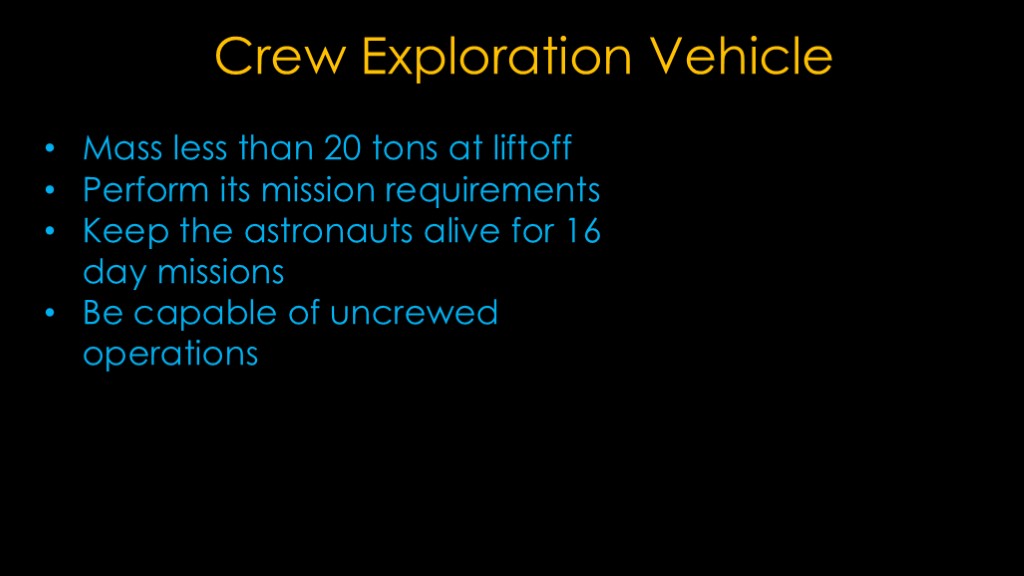
Be capable of uncrewed operations. Unlike apollo, the intention is to take all the astronauts to the lunar surface.
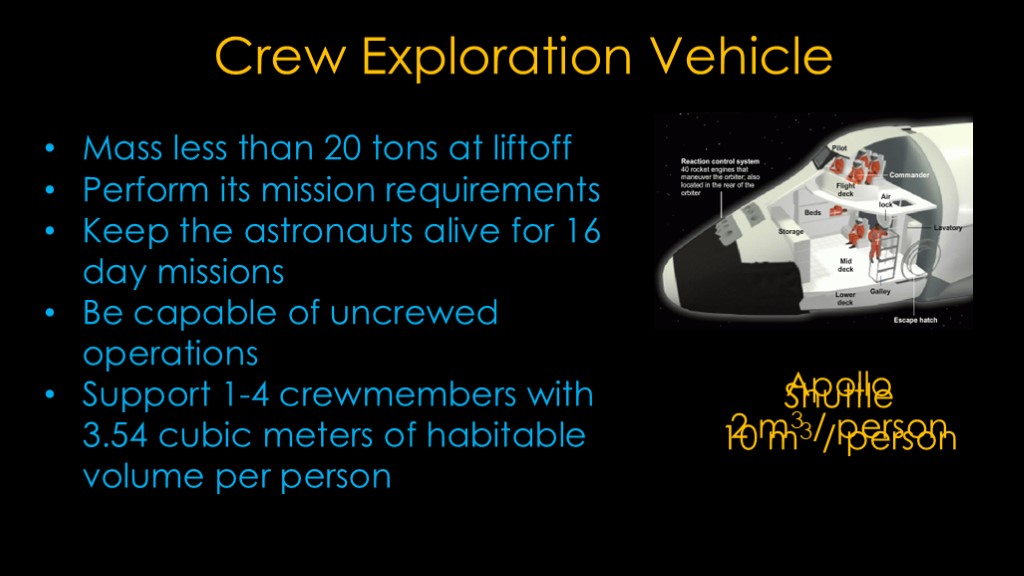
Support 1 to 4 crewmembers with 3.54 cubic meters of habitable volume per person. That's 125 cubic feet, and is an example of NASA thinking in imperial and talking in metric.
Apollo had about 2 cubic meters per person.
The shuttle *supposedly* had 10 cubic meters per person with 7 people on board. I suspect this is the full pressurized volume and doesn't include the space taken up underneath the middeck, in the avionics bay, or in the storage lockers. But its still a lot of space.
So the crew exploration vehicle needs to roughly double the space of Apollo.
Remember how I said there is more mass available in the crew exploration vehicle? One place it will go is to more space for the crew.
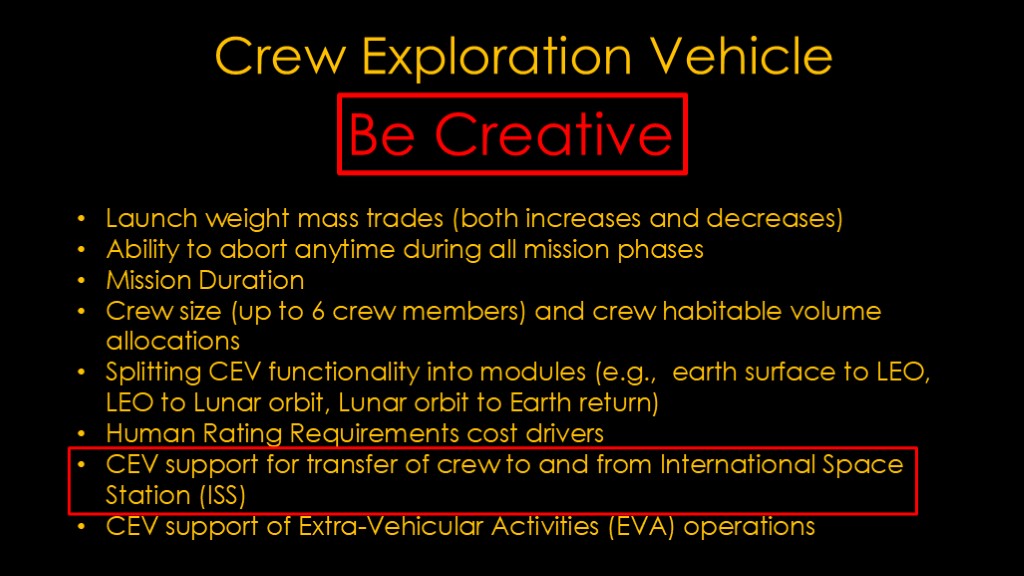
NASA also directed designers to consider other scenarios. I won't read all of these, but I do want to highlight the one that says "CEV support for transfer of crew to and from the international space station"

There was also a different development approach
They would use Spiral development, where needed capabilities would be developed incrementally in a series of spirals.
The first spiral is to test crew transport in orbit, with an objective to test this by 2014.
The second spiral extends the capability to support extended lunar exploration, where extended means "up to 4 days"
The third spiral extends that to several months, to serve as an analog for possible Mars missions.
Very much a "build a little, fly a little" approach.
They also planned what they called flight application of spacecraft technologies - or FAST - where multiple companies would develop full prototypes and there would then be a "fly off" to decide who would get the contract. This had been done in the past for military programs, but not for NASA.
Spiral from statement of objectives, document 4.
https://www.govinfo.gov/content/pkg/PLAW-109publ155/pdf/PLAW-109publ155.pdf

How does this align with NASA's mission?
I think the answer is "pretty well"; there's lots of exploration and a great chance for some innovation. And some nice competition. This feels like NASA was very much trying to do something different and something for the long term.
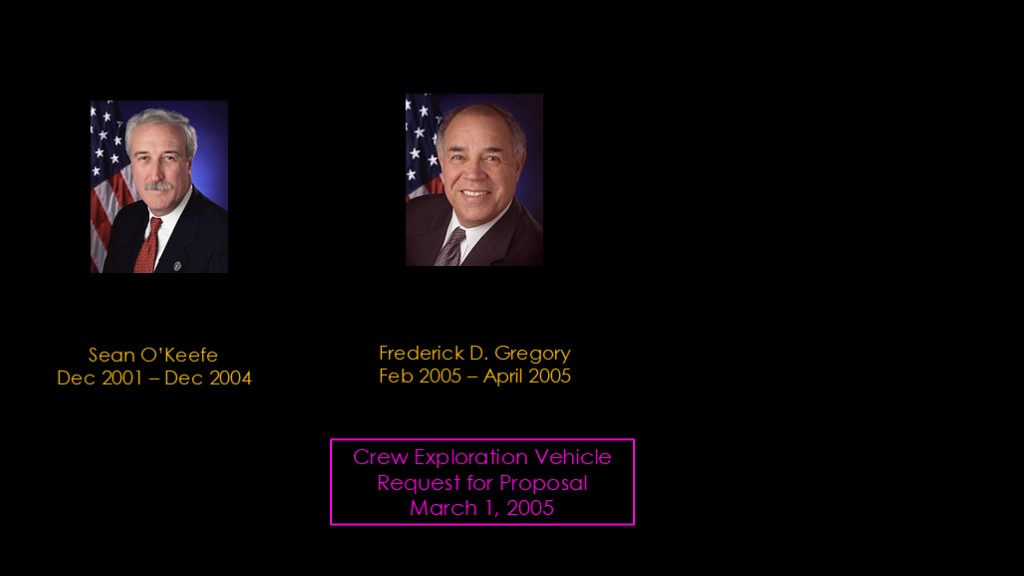
NASA is gearing up for sharing this with industry in 2005, then in December of 2004, Administrator Sean O'Keefe announced his resignation. His official reason was that the $500,000 salary he would get as the chancellor at Louisiana state university would work better to send his kids to college than the $158,000 NASA was paying him. Others have speculated that he was pushed out due to some comments he made on climate science, but the reality is that 3 years is a decent run for a NASA administrator.
Deputy administrator Frederick D. Gregory became acting administrator starting in February, and it was during this time that NASA released their request for proposal for the crew exploration vehicle with the requirements I already discussed.
There were two groups that submitted bids.
https://www.govinfo.gov/content/pkg/PLAW-109publ155/pdf/PLAW-109publ155.pdf
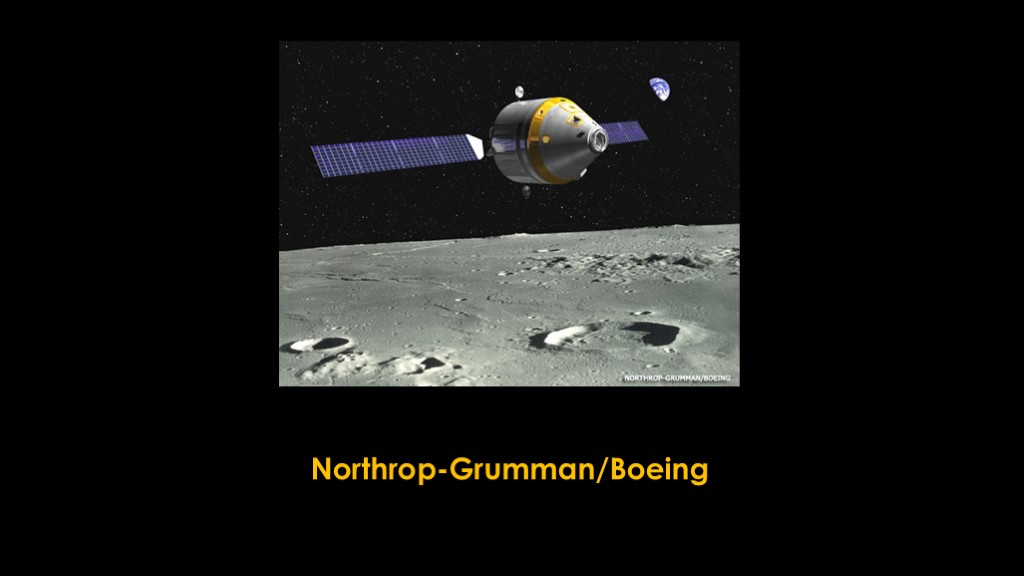
Northrop-Grumman and Boeing submitted a very Apollo-like design - a capsule for the astronauts and a service module with solar panels. Pretty much all I could find about it is this picture and a few notes saying there is very limited information.
This group had a tremendous amount of history in crewed flight - they had been involved in a lot of NASA projects, including the Lunar Module during Apollo.
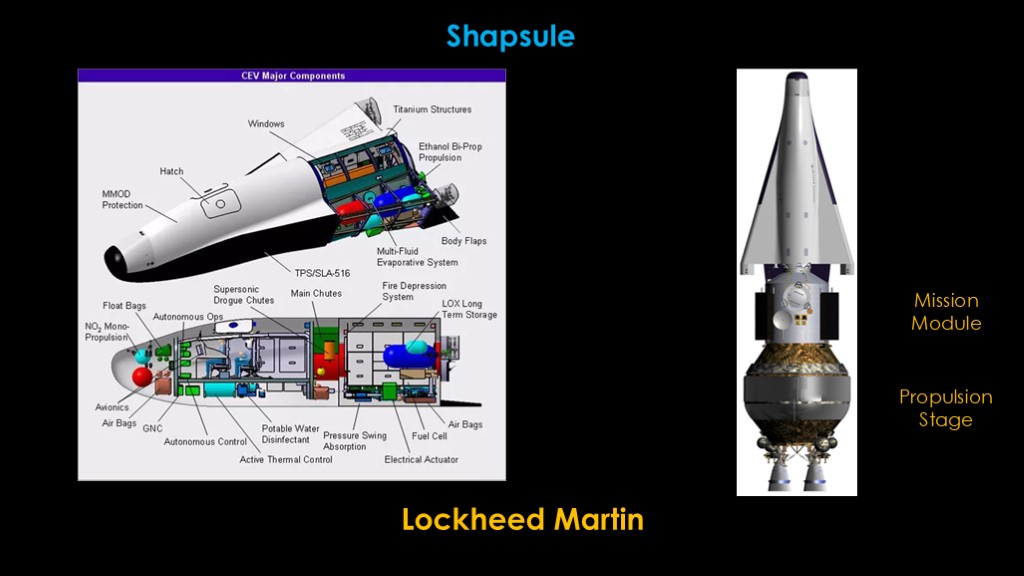
Lockheed Martin came up with a proposal that is directly based on their orbital space plane concept, along with add-ons that would allow it to go beyond low earth orbit.
One of the interesting things about this design is that its shuttle-like in the sense that it reenters like a plane, but when it has slowed down enough, it will pop drogue chutes, main chutes, and then land on air bags, just like a capsule.
I'm calling it a Shapsule.
I think the orbital space planes deserved funding, and this approach does as well; it aligns well with what NASA should be doing. It pushes the state of that art but is making a small leap rather than a big one.
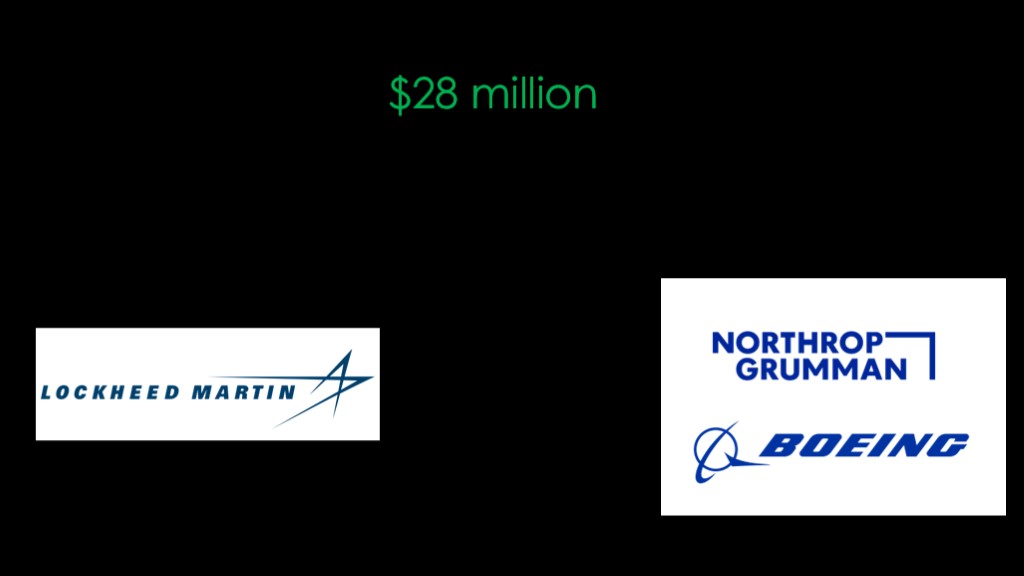
Given that you know that Orion is a capsule, you may have guessed that NASA chose the capsule design, but in fact, NASA awarded $28 million to both bidders to begin design work.
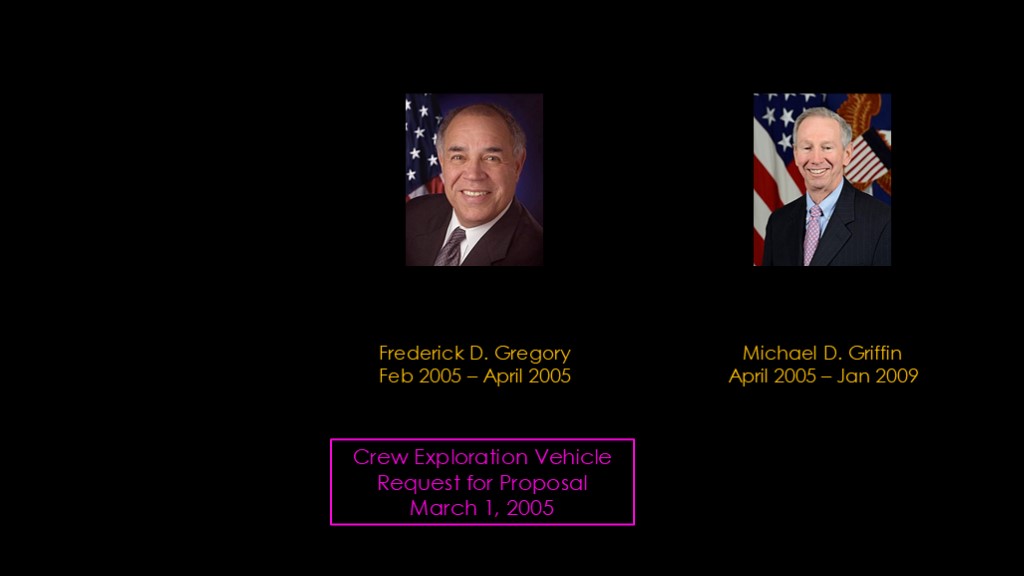
While this was going on, Michael D. Griffen was nominated as the new NASA administrator on March 11 and confirmed in early April.
This would lead to a major change in trajectory for the program. Ha ha.
https://www.govinfo.gov/content/pkg/PLAW-109publ155/pdf/PLAW-109publ155.pdf
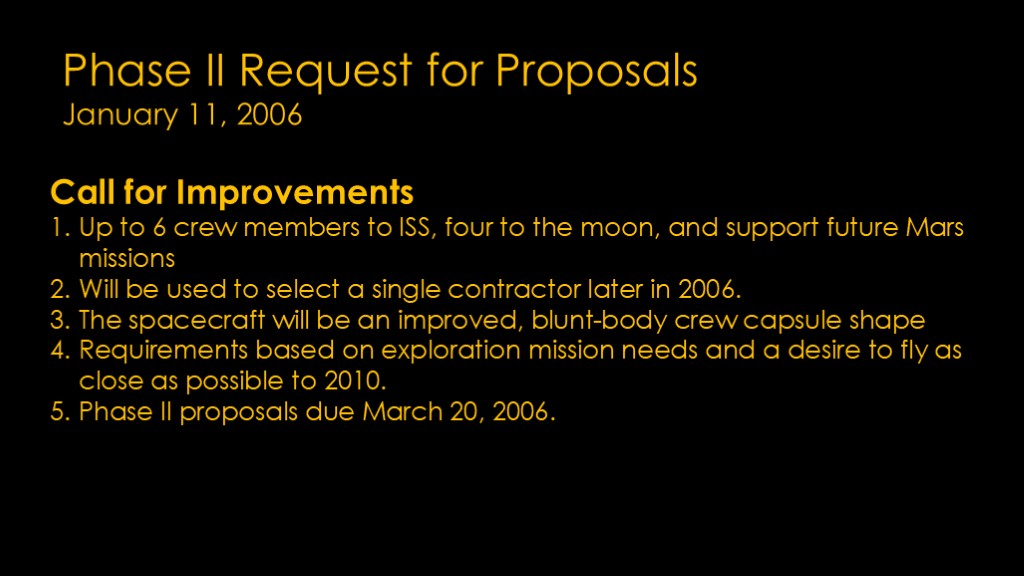
In January of 2006, NASA released a revision of the previous RFP. What NASA creatively called a "Call for Improvements"
Here's a summary of what changed:
Up to 6 crew members to ISS, four to the moon, and support future Mars missions.
Will be used to select a single contractor later in 2006. Both the spiral approach and the FAST fly-off is gone.
The spacecraft will be an improved, blunt-body crew capsule shape. No Shapsules allowed.
Requirements based on exploration mission needs and a desire to fly as close as possible to 2010
Phase II proposals due march 20, 2006. So, two months to "improve" your proposal.
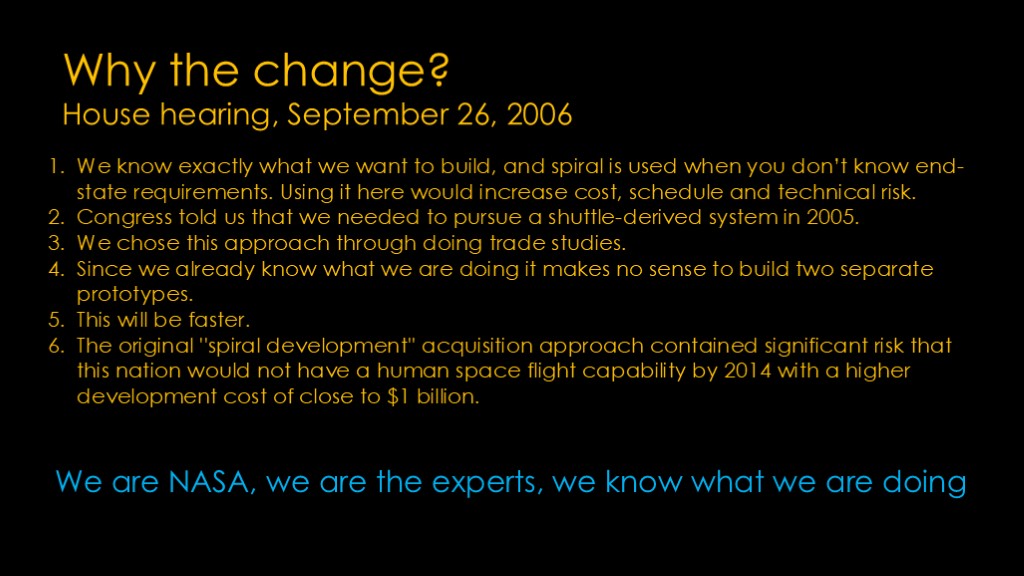
NASA was asked in congressional hearings about the change of approach, and they gave a lot of reasons for the change. I won't read them all, but a good summary is
We are NASA, we are the experts, we know what we are doing.
http://commdocs.house.gov/committees/science/hsy29949.000/hsy29949_0.HTM
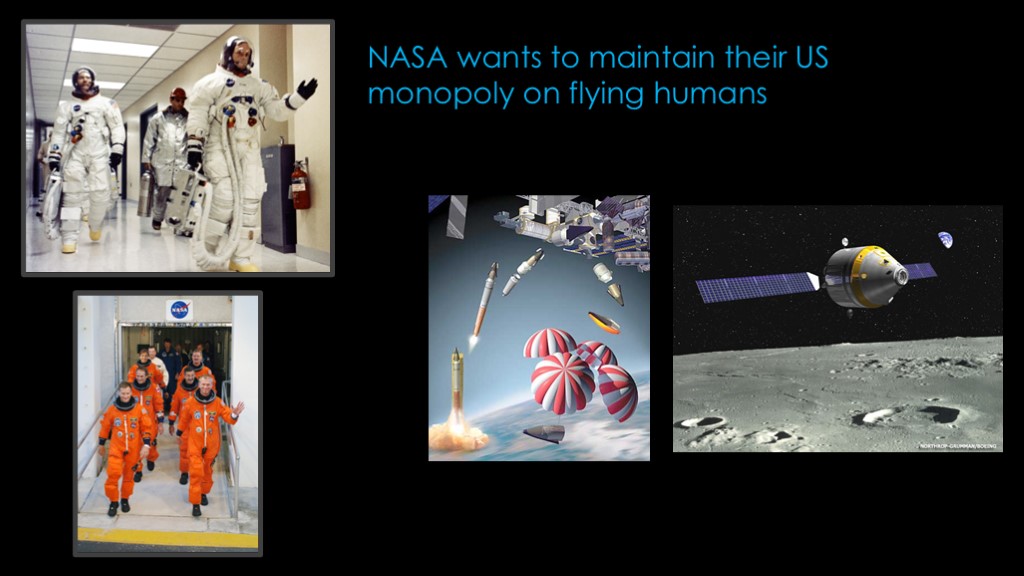
That's not the real reason.
The real reason is that NASA wants to maintain their US monopoly on flying humans.
It's pretty obvious that the Lockheed concept is going to have a version that is light enough to fly on Atlas V, and it's a fair bet that the Northrop Grumman / Boeing approach would be able to do the same thing - especially since NASA asked them specifically to try to support that scenario.
That is precisely what some people at NASA - including their new administrator - do not want to happen. The point of the changes are to keep that from happening. I'll talk about how that worked in a bit.

What we got out of the Phase II request was not only a capsule, but a big capsule. Here's what it would look like.
The Orion designation would come the next year, giving us the Orion Crew Exploration Vehicle.
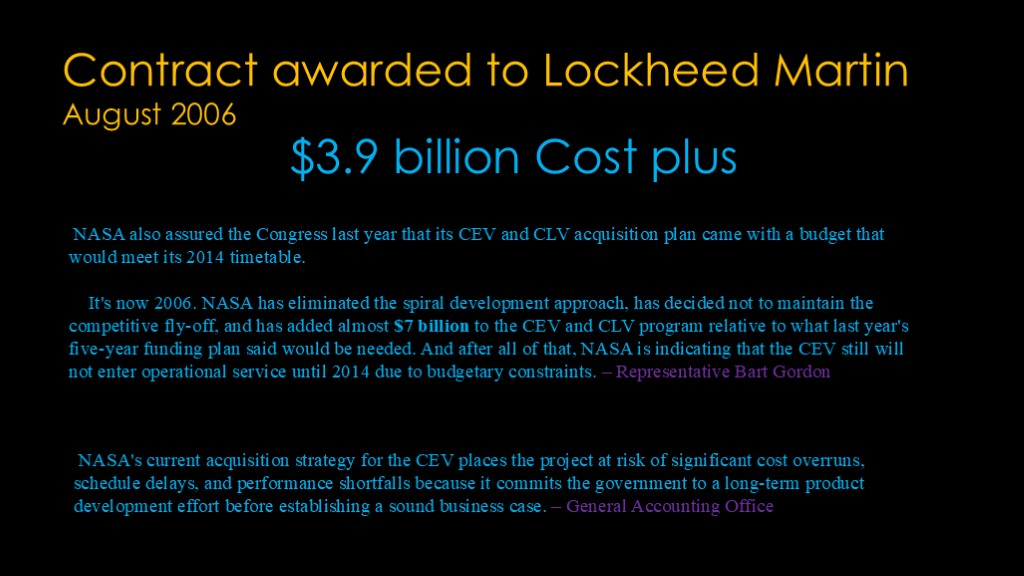
In a big surprise, Lockheed Martin was awarded the orion contract in August of 2006. It was a cost-plus contract for development and two flight test capsules, in the amount of $3.9 billion.
I think it's fair to say that many people were not happy.
Read Bart Gordon
Read General account office
But Congress decided to let NASA continue.
http://commdocs.house.gov/committees/science/hsy29949.000/hsy29949_0.HTM
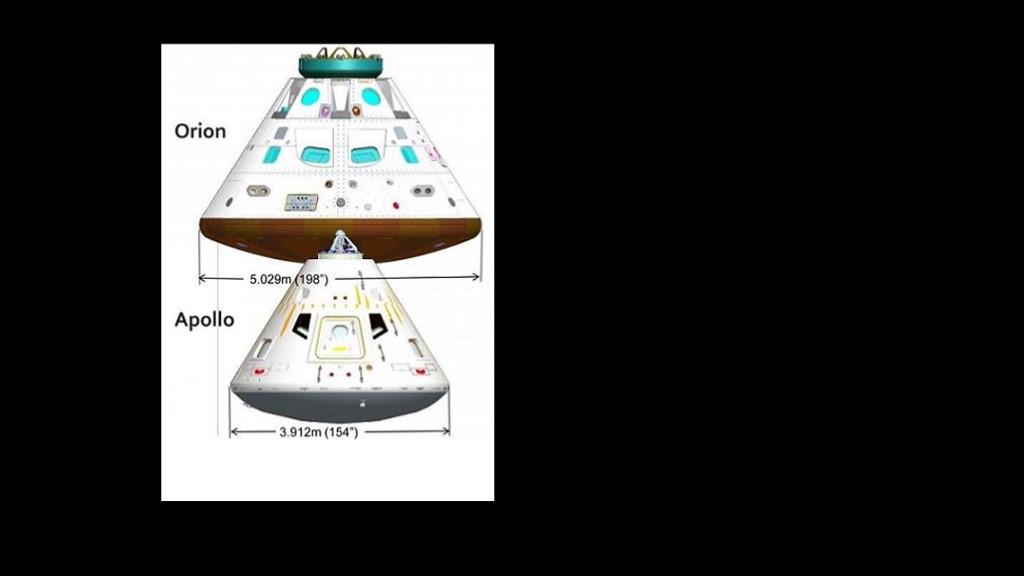
Now we have a new capsule, and it's a big capsule.
If we compare it to Apollo, we can see that it's a meter wider and a bit taller. That means a lot more space inside.
If we add in the two commercial crew capsules - both of which could carry 6 passengers to the ISS - we can see it's still a very big capsule.

We can find some of the justification for this in the NASA exploration system documents.
The size of Orion was based on sending 4 crew members to the moon. If you look at these highlighted numbers, the total vehicle masses about 23,000 kg and has 1724 meters per second of delta v. That's more than enough delta v if you are doing the constellation architecture, but probably not enough if you need to put yourself into orbit. You are at least 300 meters per second short.
Michael Griffin called this design "Apollo on Steroids"; it is a very big capsule but it's not really a very capable system.
Remember where I talked about NASA wanting to be the only ones who flew crew?
That shows up here in the ISS section. The ISS vehicle is only 253 kilograms lighter than the lunar one, and it has a ridiculous amount of delta v; probably 4x what you need for the ISS mission. Why would they do that?
Time for some numbers. Given the total mass and the delta-v, we can figure out how much fuel they are carrying to get that delta-v. For the ISS version, it's about 9 tons, and for the lunar version, about 10 tons.
So the ISS version that can do 1544 meters per second of delta-v has a mass of 22.9 tons. What if we relax that delta-v required to something more realistic, like 400 meters per second.
The fuel mass drops *way* down, and the total mass is now 15.6 tons.
https://www.nasa.gov/pdf/140649main_ESAS_full.pdf
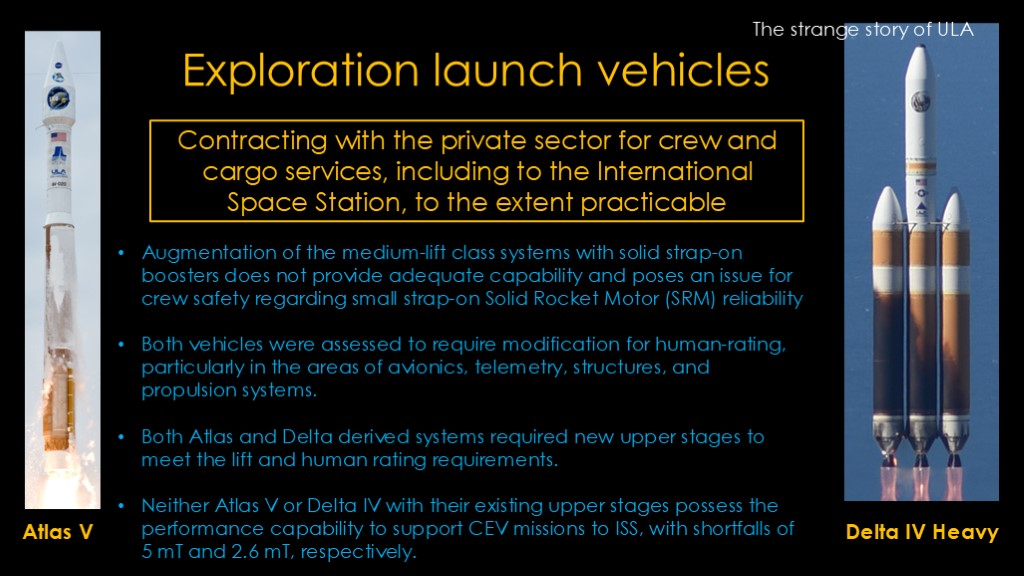
Remember that congress has mandated that NASA look at commercial solutions.
There were two possible options - the Atlas V from Lockheed Martin and the Delta IV Heavy from Boeing. At about this same time, the parent companies would merge the rockets into a new company known as United Launch Alliance. That's another strange story; see the link to my video that talks about it.
NASA needs to come up with reasons why neither of these are practical. Here's what they come up with:
(read)
Note that they are arguing against small solid rocket motors when they will in the very next page argue that using a large solid rocket motor is fine.
(read)
This is a fair concern; there will need to be work done to crew rate these vehicles.
(read)
A new or upgraded upper stage would be required. Just like the new upper stage required for the NASA-preferred approach.
(read)
This is why they switched to a capsule, and this is why the ISS version of Orion is so damn heavy. If you take that extra fuel away, these performance shortfalls evaporate. It's all about keeping crew away from commercial launchers.
https://www.nasa.gov/pdf/140649main_ESAS_full.pdf, page 40

Of course, that Atlas V that was not suited for human flights to the space station would be chosen by Boeing to be used for commercial crew flights of their Starliner capsule to the space station.
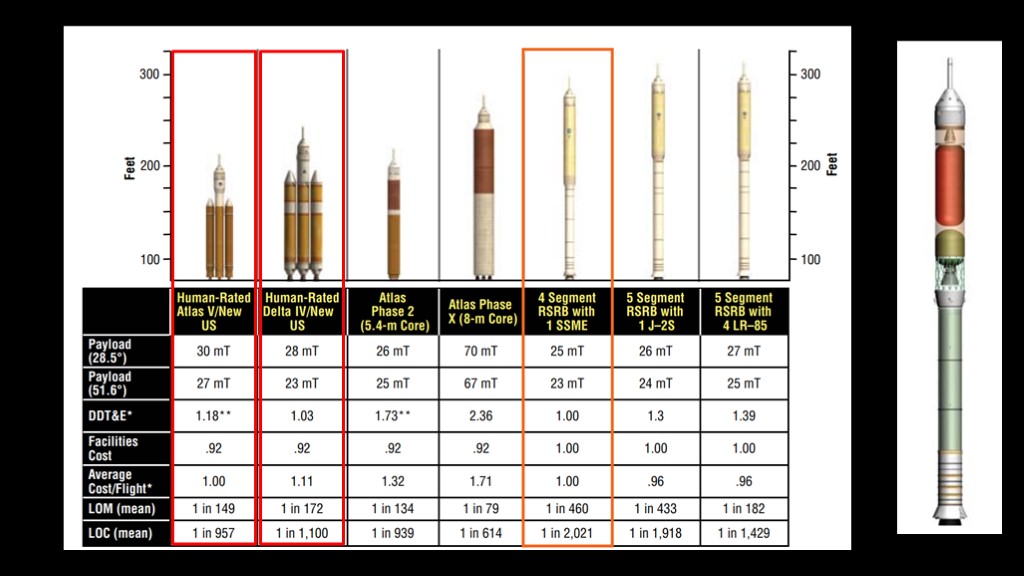
NASA ends up specifying a design that became known as the Ares I. I'll talk about the details in a future video, but suffice it to say that it's a shuttle solid rocket booster with a new hydrogen/oxygen second stage.
NASA asserts in this slide that it's a $1 billion / flight launcher.
This one on the left is the triple-core Atlas V Heavy. Atlas V is - by itself - somewhere around $200-$250 million. It may be kindof pricey to develop the heavy variant - SpaceX spent a lot of effort on Falcon Heavy - but it seems unlikely that the cost per flight goes up 4x.
Next to it we have Delta IV Heavy. It needs a new second stage, and it might need engine modifications, but the changes seem a lot easier than Atlas V. Somehow that new second stage triples the cost of the existing launcher, one that is very expensive right now because so few are built.
Anyway, that finishes the discussion of launchers and explains why NASA needed such a big and heavy capsule; they needed one that couldn't be easily launched by commercial launchers.

Time passed...
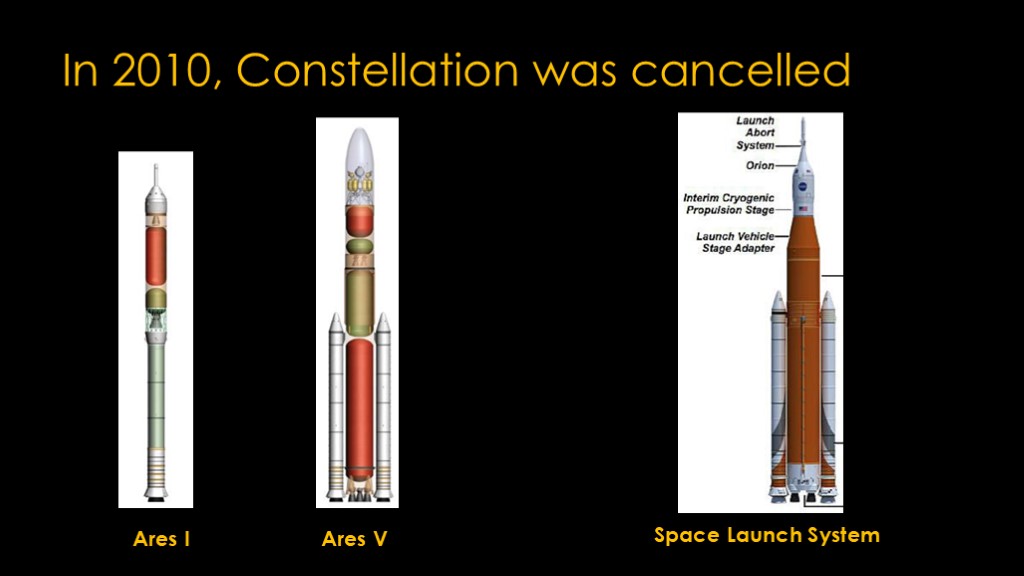
In 2010, a review of constellation found that it was unaffordable, and it was cancelled by the Obama administration.
That's not really allowed, and congress quickly revived it in a different form.
The net effect was to cancel the Ares I launcher and move Orion onto the Ares V launcher, now renamed "Space Launch System".

In addition the three Orion variants were merged into one Orion to rule them all.
There was also a rebranding, from the Orion crew exploration vehicle to the Orion Multi-purpose crew vehicle.
Which is a good name if you consider the purposes to be:
Going to the moon
Coming back from the moon
Everybody knows there is no chance NASA will use this launcher to send a capsule to ISS, and there's no Mars plan, so it's all about the moon.
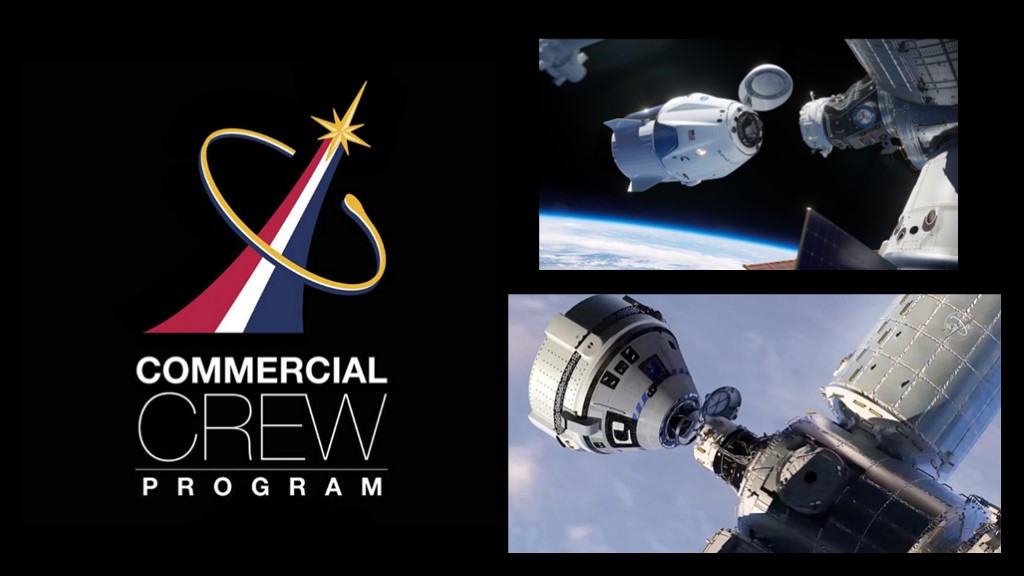
The same act that gave us SLS and continued Orion gave us the commercial crew program that would see both Crew Dragon and Starliner capsules dock with the ISS.
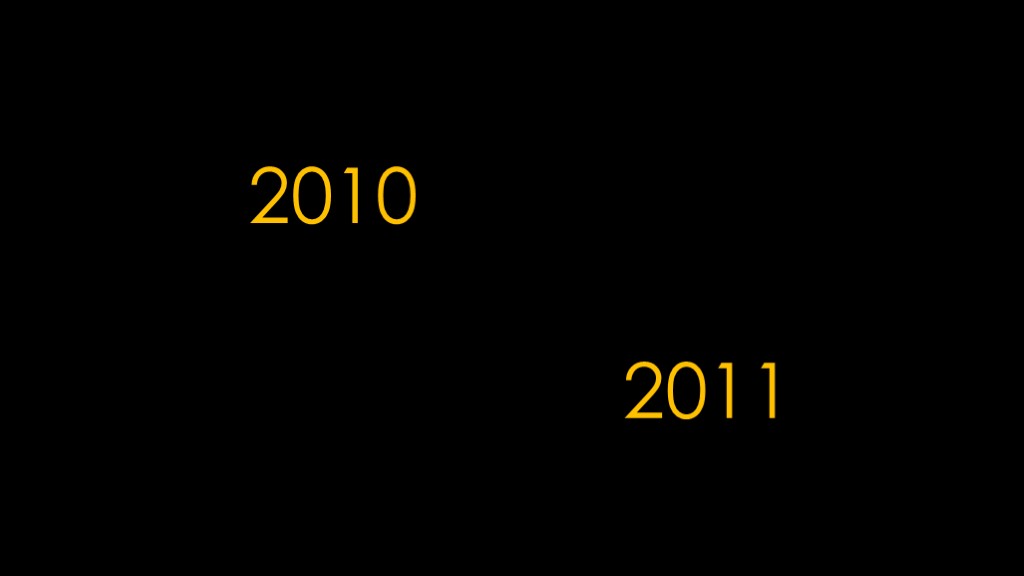
Time passes.
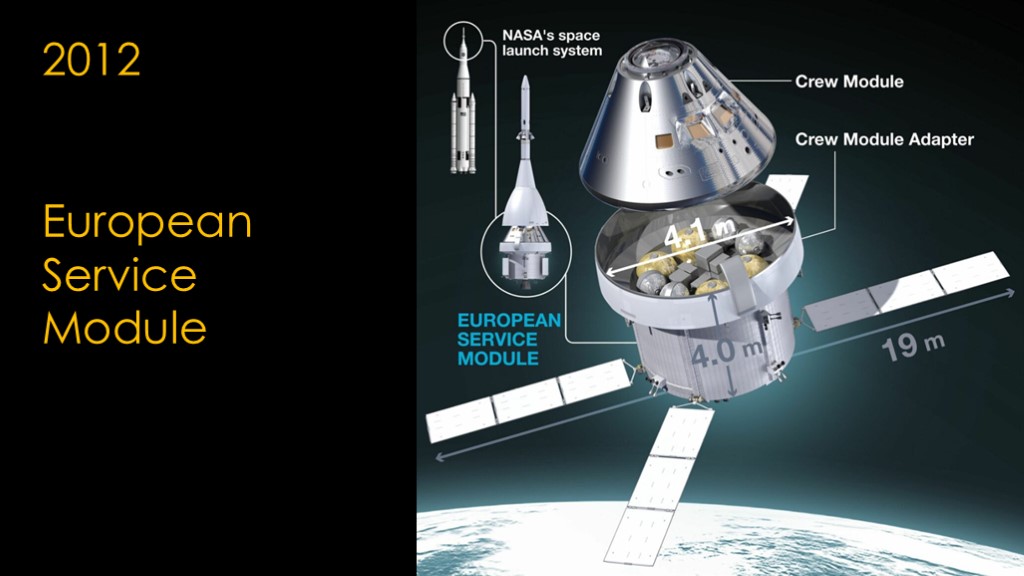
In 2012, the European space agency agreed to construct the service module for Orion, thereby sharing the costs with NASA. This slightly reduced the amount of delta-v available.
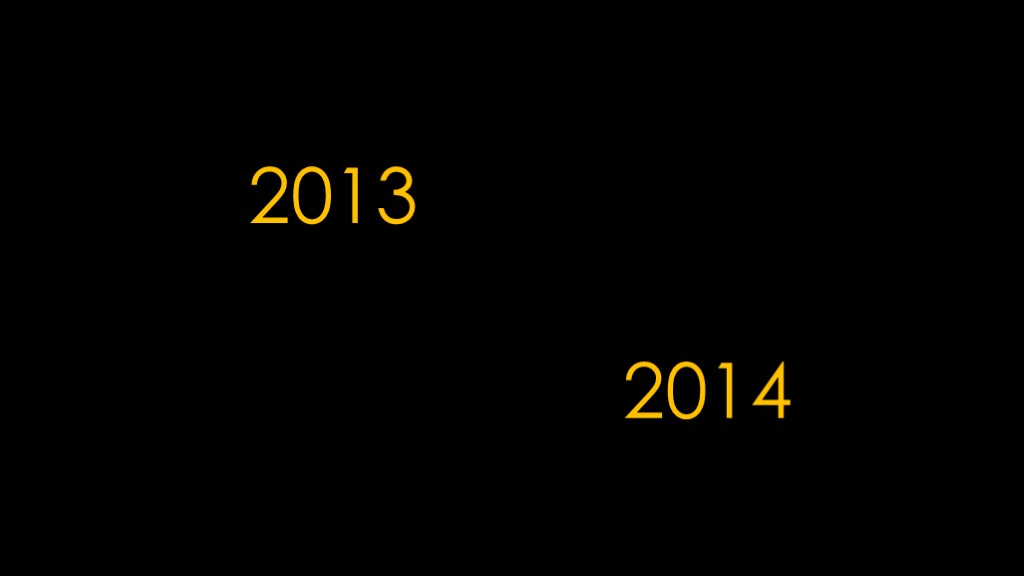
Time passes.
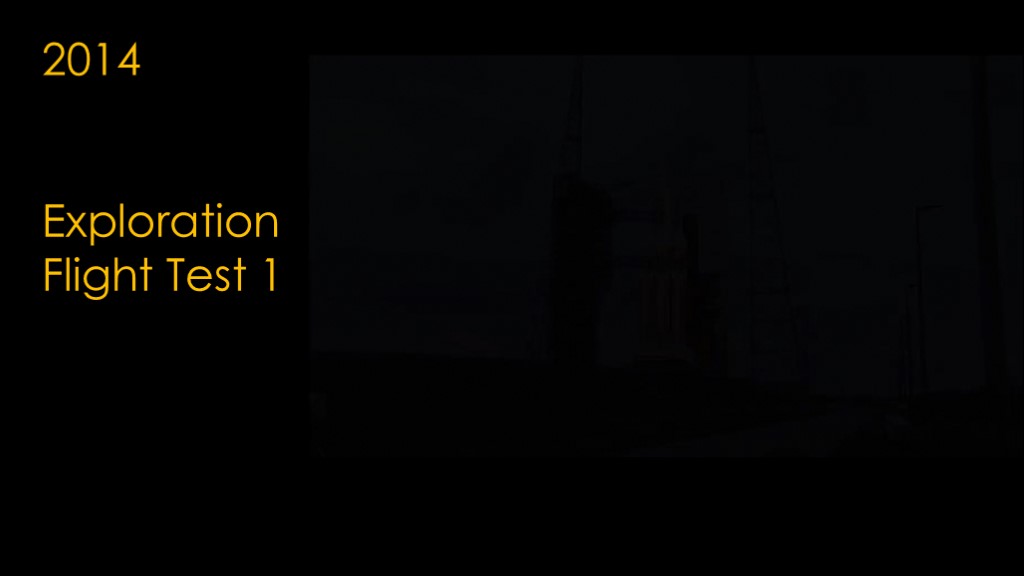
In 2014, Orion flew on Exploration Flight Test 1.
And yes, that's a Delta IV Heavy, the same Delta IV Heavy that was an unacceptable choice as a launch vehicle.
Though to be fair, this was an uncrewed test flight.
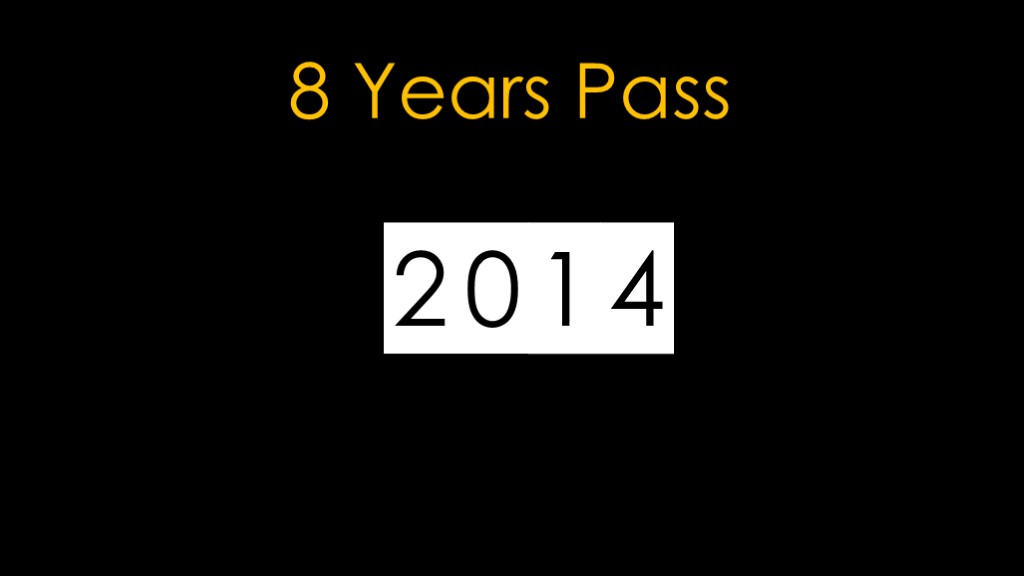

And now it's time to talk about one of Orion's little secrets, an outgrowth of the constellation architecture.
You remember this chart from earlier, which said that Orion would have 1724 meters per second of delta V.
Orion has gotten heavier and the service module has gotten smaller, so that figure has dropped to 1350 meters/second. If we reserve some delta v for safety, that takes it down to 1250 meters/second.
To get into and out of a reasonably low lunar orbit takes at least 1800 meters/second.
Orion was designed for the Constellation approach, but with the Artemis approach, Orion can get into a low lunar orbit, but it cannot get out of it. Which would seem to be a drawback for a crew vehicle.
https://ntrs.nasa.gov/api/citations/20150019648/downloads/20150019648.pdf
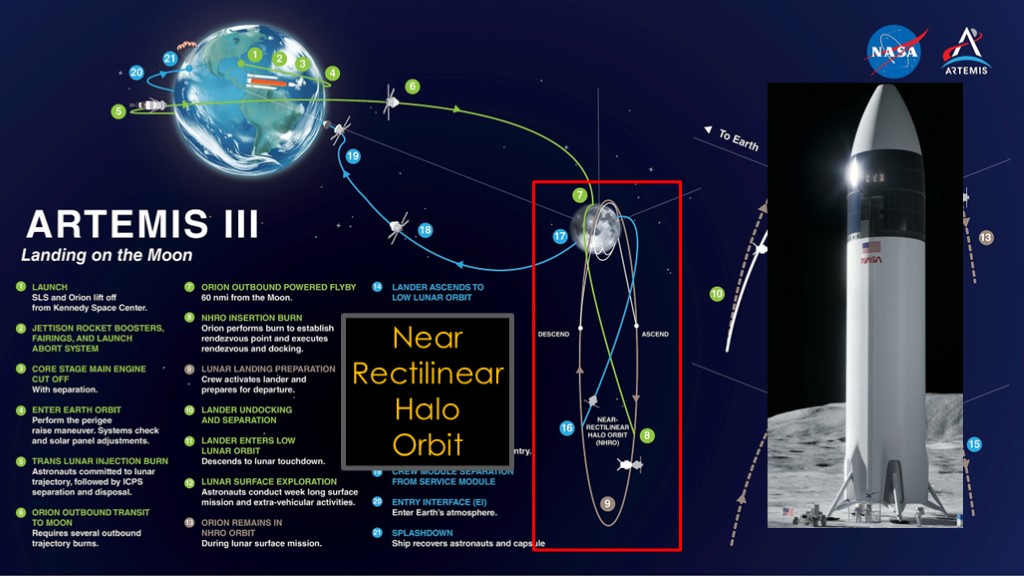
The Artemis missions therefore use a Near Rectilinear Halo Orbit; it costs less than 900 meters per second of total delta v, and that's comfortably within the capability of Orion.
The downside is that the delta-v needs to be made up by the lander; it has to make a transition from the halo orbit to low lunar orbit and land from there, and do the reverse to return to the orion capsule.
That pushes the delta-v requirement from about 4000 meters per second up to 5500 meters per second. Much harder to build a lander that can do that than to do what the lunar module did.
SpaceX won the Human Landing System contract with lunar starship, which is able - with refueling in low earth orbit - to make it to the near rectilinear halo orbit, down to the lunar surface, and then back to the near rectilinear halo orbit. SpaceX's bid was relatively low because they are already building starship, but the other bids were very high because the landers needed to have so much delta-v.
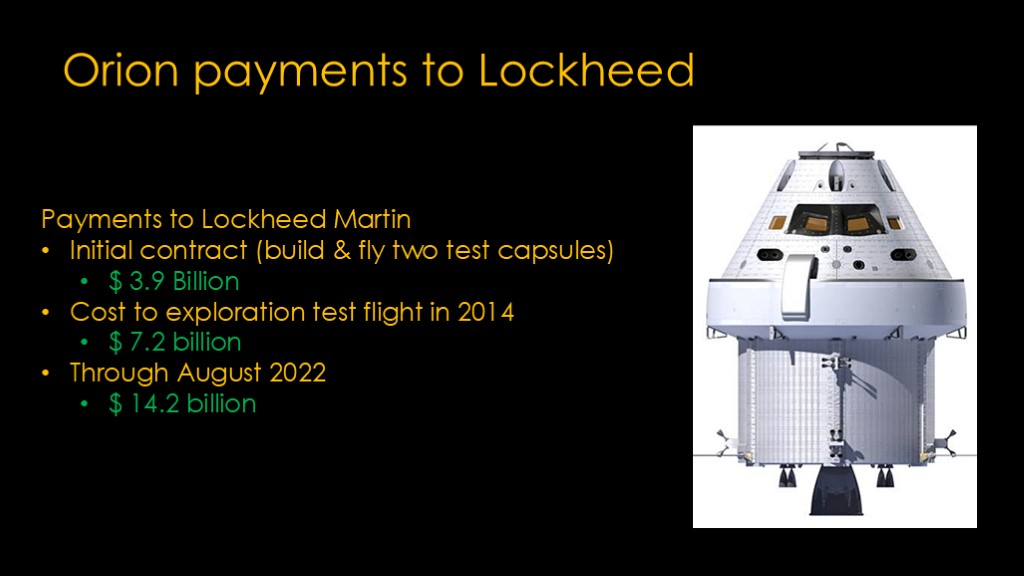
So how much has Orion cost?
If we look purely at the payments to Lockheed martin, the initial contract to build and fly two test capsules was $3.9 billion.
The cost up to the exploration test flight in 2014 was $7.2 billion.
And through August of 2022 they have been paid $14.2 billion.
Orion has been a tremendously lucrative program for them.
https://www.usaspending.gov/award/CONT_AWD_NNJ06TA25C_8000_-NONE-_-NONE-

NASA of course adds overhead on top of the Lockheed Martin costs.
Through the exploration test flight in 2014, NASA spend $10.8 billion on Orion.
Through August 2022, they have spent more than $20 billion
There has been a lot of flak aimed at Boeing for cost overruns in the development of SLS, but nobody is asking Lockheed Martin what they are spending $1 billion / year on.
https://www.usaspending.gov/award/CONT_AWD_NNJ06TA25C_8000_-NONE-_-NONE-
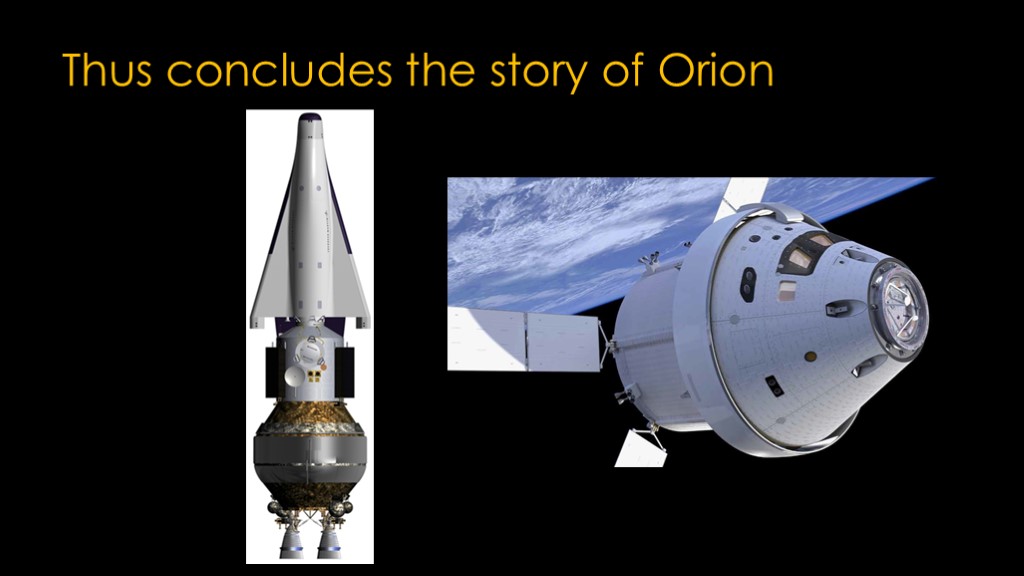
Thus concludes the story of Orion. A tragic story of how we could have had an interesting and innovative Shapsule to carry humans to low earth orbit and beyond, but instead ended up with a big heavy capsule that isn't a great fit for the mission that it is being used for.
But it did send $14 billion to Lockheed Martin, and that at least means something.

If you enjoyed this video, please make a donation to the "Save the Shapsules" fund.